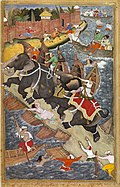File:Babur and his army emerge from the Khwaja Didar Fort.jpg
From Wikimedia Commons, the free media repository
Jump to navigation
Jump to search

Size of this preview: 333 × 599 pixels. Other resolutions: 133 × 240 pixels | 559 × 1,006 pixels.
Original file (559 × 1,006 pixels, file size: 173 KB, MIME type: image/jpeg)
File information
Structured data
Captions
Captions
Add a one-line explanation of what this file represents
Summary
[edit]| Artist |
Drawn by
artist QS:P170,Q728311 , Painted by Dharm Dás |
|||||||||||||||||||||||
| Description |
English: The "Memoirs of Babur" or Baburnama are the work of the great-great-great-grandson of Timur (Tamerlane), Zahiruddin Muhammad Babur (1483-1530). The Baburnama tells the tale of the prince's struggle first to assert and defend his claim to the throne of Samarkand and the region of the Fergana Valley. After being driven out of Samarkand in 1501 by the Uzbek Shaibanids, he ultimately sought greener pastures, first in Kabul and then in northern India, where his descendants were the Moghul (Mughal) dynasty ruling in Delhi until 1858.
The miniatures are from an illustrated copy of the Baburnama prepared for the author's grandson, the Mughal Emperor Akbar. It is worth remembering that the miniatures reflect the culture of the court at Delhi; hence, for example, the architecture of Central Asian cities resembles the architecture of Mughal India. Nonetheless, these illustrations are important as evidence of the tradition of exquisite miniature painting which developed at the court of Timur and his successors. Timurid miniatures are among the greatest artistic achievements of the Islamic world in the fifteenth and sixteenth centuries.Illustrations of Mughals from the Baburnama |
|||||||||||||||||||||||
| Date | between 183 and 1530 | |||||||||||||||||||||||
| Collection |
institution QS:P195,Q6373 |
|||||||||||||||||||||||
| Accession number |
2000,0616,0.1 |
|||||||||||||||||||||||
| Source/Photographer | Baburnama | |||||||||||||||||||||||
Licensing
[edit]|
This is a faithful photographic reproduction of a two-dimensional, public domain work of art. The work of art itself is in the public domain for the following reason:
The official position taken by the Wikimedia Foundation is that "faithful reproductions of two-dimensional public domain works of art are public domain".
This photographic reproduction is therefore also considered to be in the public domain in the United States. In other jurisdictions, re-use of this content may be restricted; see Reuse of PD-Art photographs for details. | |||||
File history
Click on a date/time to view the file as it appeared at that time.
| Date/Time | Thumbnail | Dimensions | User | Comment | |
|---|---|---|---|---|---|
| current | 14:06, 6 November 2012 |  | 559 × 1,006 (173 KB) | Baloo1000 (talk | contribs) | User created page with UploadWizard |
You cannot overwrite this file.
File usage on Commons
The following page uses this file:

